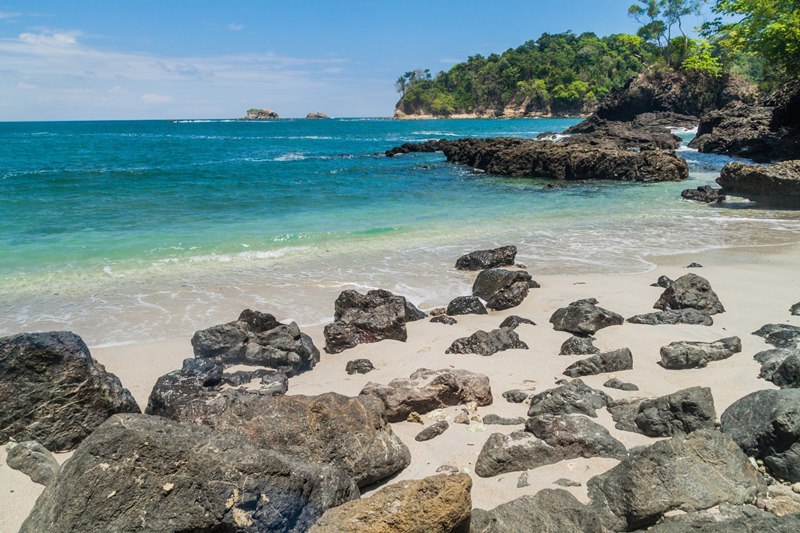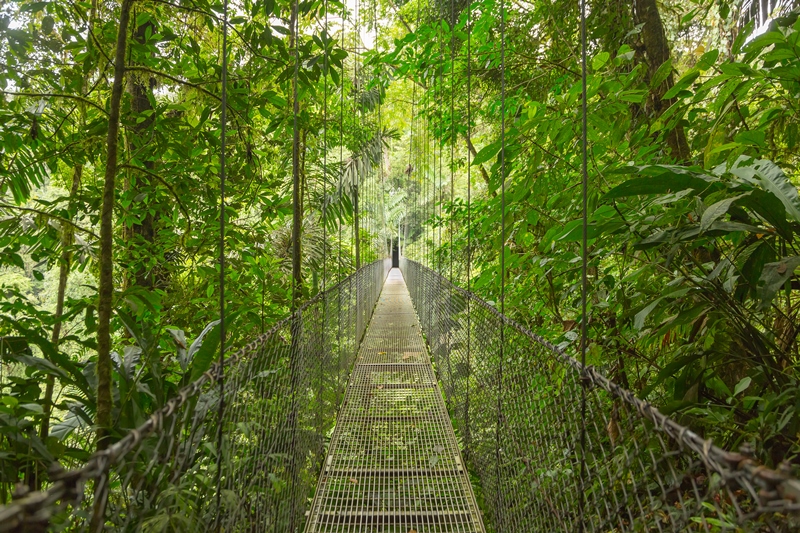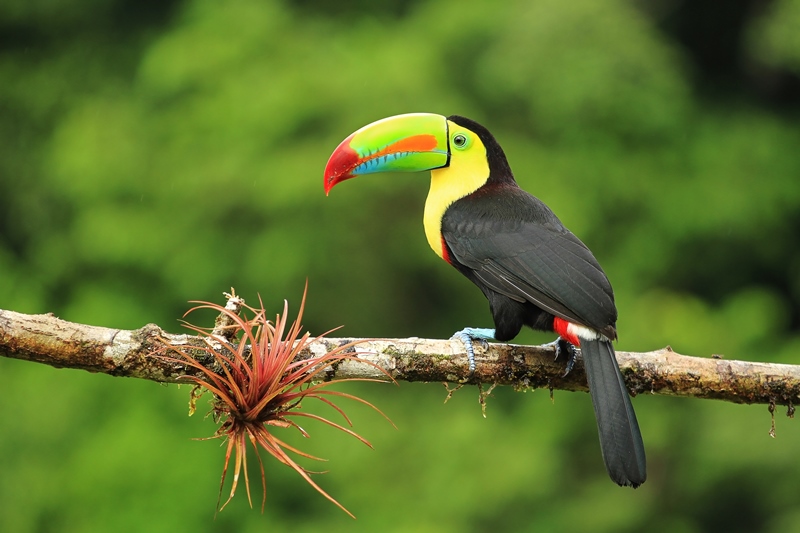Arenal National Park
Arenal is perhaps Costa Rica’s most famous national park. Encompassing eight of Costa Rica’s 12 different ecosystems, the park includes hot springs, cloud forest, an active volcano and waterfalls. The park was upgraded from a reserve in 1994, and its main attraction, the Arenal Volcano, can be seen from miles around with its perfect cone often topped with a plume of smoke or scudding clouds. The volcano lay dormant until 1968 when a massive eruption devastated the western flank; it’s been smouldering ever since, with lava flows, dusk plumes and pyroclastic flow not uncommon. On a Cycle Costa Rica tour, you'll experience stunning views of the volcano as you pedal round the lake.
How big is it?
Enormous – around 12,200 hectares, including a volcano!
What can I see there?
Aside from the volcanic activity, almost all of Costa Rica’s 850 species of identified birds can be seen here; this includes the beautiful and endangered resplendent quetzal bird. You could also spot white-faced capuchin monkey, jaguar, deer, coti and several species of snake, as well as an impressive array of plants such as orchid, fern, bromeliad and the curiously-named strangler fig.

Cahuita National Park
Small but perfectly formed, Cahuita National Park was created in 1970 to protect the colourful coral reef that lies just offshore – some of the best in the country. Golden sandy beaches and swaying coconut palms may seem more like a Caribbean island paradise than a national park, but its vital conservation helps to protect the coral that has suffered at the hands of earthquakes, chemical run-off from banana plantations and increased sediment due to deforestation. There are a number of walking trails that lace through the park, offering stunning views of the coast.
How big is it?
Blink and you’ll miss it: the land-based area is just 1,106 hectares, while the protected marine area covers a much larger 22,400 hectares.
What can I see there?
A fantastic array of wildlife! On land you may spot howler monkey, coati, raccoon and a variety of snakes, plus birds such as green ibis and also colourful butterflies. Under the waves you’ll see brain coral and sea fans, with brightly-coloured coral fish.

Manuel Antonio National Park
Located on the central Pacific Coast, Manuel Antonio is one of Costa Rica’s most popular national parks, encompassing rainforest, mangroves, white sandy beaches, coral reefs and a huge variety of wildlife. The small protected area is home to a large number of animal species, including pacas, agoutis and iguanas – experienced guides can help you to get closer to the wildlife while remaining an unobtrusive observer. The best way to explore is via the network of walking trails, which are ideal for spotting the monkeys that call the national park home.
How big is it?
Easily explored, hence its popularity; it’s around 1,983 hectares, with a further 55,000 hectares of protected marine reserve.
What can I see there?
The elusive wildlife hear includes iguanas, agoutis, white-faced capuchin monkey and the rare and endangered squirrel monkey. Offshore, there are a dozen or so coastal islands which provide refuge to nesting seabirds.

Monteverde Cloud Forest
Getting here is half the fun, as you’ll need to traverse a system of bumpy roads to reach the cloud forest. However, once there, the adventure begins as you travel deep into an agricultural community that is largely cut off from the rest of Costa Rica, meaning some of the most authentic and natural experiences you won’t find elsewhere. Founded in the 1970s, Monteverde Cloud Forest is privately owned and administered by a tropical science centre. The forest is shrouded in mist for much of the year, meaning stunted tree life and extensive epiphytic growth, such as orchids and bromeliads. On a Highlights of Costa Rica tour you can witness this ethereal cloud forest reserve yourself.
How big is it?
Very large, some 10,500 hectares, and straddling the continental divide. Its size and location means it is an exceptional example of a cloud forest ecosystem.
What can I see there?
Over 100 species of mammals (monkey, tapir, jaguar, ocelot, puma). Around 500 species of butterfly; 2,500 types of plant; 400 species of bird; 6,000 kinds of insect. Binoculars at the ready!

Tortuguero National Park
One of Costa Rica’s greatest national treasures, Tortuguero National Park is included on most itineraries in Costa Rica thanks to its incredible diversity. The park is made up of a network of waterways, vast plains and dense tropical forest, bursting with vegetation and birdlife. The park is also one of the most important green turtle nesting sites in the western Caribbean, and in season (June to October, only after dark) you’ll get to observe from afar as significant numbers of turtle descend on the beach to lay their eggs. As well as green turtle you many also spot leatherback (between March and June), hawksbill and the occasional loggerhead turtle. On a Costa Rica Wildlife Tour, you can also spot sloth.
How big is it?
One of the largest – 31,187 hectares of coastal reserve.
What can I see there?
Tortuguero is exceptionally diverse, so expect a plentiful supply of birds and reptiles, as well as the more elusive green turtles, toucans, green macaws, howler monkeys, sloth, jaguar, manatee and tapir which grace their presence on a lucky few.

Ready to go?
View all Costa Rica tours